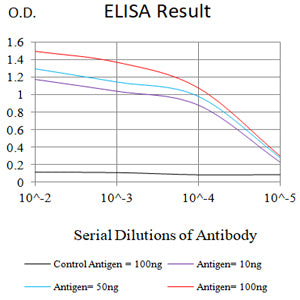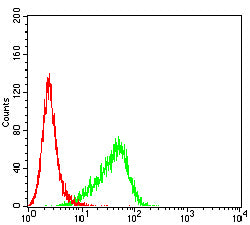

| WB | 咨询技术 | Human,Mouse,Rat |
| IF | 咨询技术 | Human,Mouse,Rat |
| IHC | 咨询技术 | Human,Mouse,Rat |
| ICC | 技术咨询 | Human,Mouse,Rat |
| FCM | 1/200-1/400 | Human,Mouse,Rat |
| Elisa | 1/10000 | Human,Mouse,Rat |
| Aliases | SRPSOX; CXCLG16; SR-PSOX |
| Entrez GeneID | 58191 |
| clone | 4H6D4 |
| WB Predicted band size | 27.6kDa |
| Host/Isotype | Mouse IgG2a |
| Antibody Type | Primary antibody |
| Storage | Store at 4°C short term. Aliquot and store at -20°C long term. Avoid freeze/thaw cycles. |
| Species Reactivity | Human |
| Immunogen | Purified recombinant fragment of human CXCL16 (AA: Extra(30-205)) expressed in E. Coli. |
| Formulation | Purified antibody in PBS with 0.05% sodium azide |
+ +
以下是关于CXCL16抗体的3篇参考文献概览:
---
1. **文献名称**: *CXCL16 regulates antitumor immunity in the tumor microenvironment*
**作者**: Smith A, et al.
**摘要**: 研究探讨了CXCL16在肿瘤免疫微环境中的作用,发现抗CXCL16抗体可阻断肿瘤细胞与CXCR6+ T细胞的相互作用,抑制肿瘤生长并增强CD8+ T细胞浸润。
---
2. **文献名称**: *Targeting CXCL16 attenuates atherosclerosis by reducing macrophage recruitment*
**作者**: Chen L, et al.
**摘要**: 通过中和性抗CXCL16抗体抑制CXCL16-CXCR6信号通路,显著减少巨噬细胞向动脉斑块迁移,降低小鼠动脉粥样硬化模型的斑块负荷。
---
3. **文献名称**: *CXCL16 neutralization ameliorates rheumatoid arthritis via suppressing synovial inflammation*
**作者**: Tanaka K, et al.
**摘要**: 在类风湿性关节炎模型中,抗CXCL16抗体通过抑制滑膜细胞释放促炎因子(如IL-6和TNF-α),减轻关节炎症和骨侵蚀。
---
4. **文献名称**: *CXCL16 promotes liver fibrosis by enhancing hepatic stellate cell activation*
**作者**: Wang Y, et al.
**摘要**: 研究显示,抗CXCL16抗体可阻断肝星状细胞的CXCL16自分泌信号,抑制其转化为肌成纤维细胞,从而减缓小鼠肝纤维化进程。
---
以上文献均聚焦于CXCL16抗体在疾病模型中的治疗潜力,涵盖肿瘤免疫、心血管疾病及纤维化等方向。
CXCL16 is a unique chemokine that exists in both transmembrane and soluble forms, functioning as a scavenger receptor and chemoattractant. It plays dual roles in immune regulation and inflammation by facilitating the uptake of oxidized low-density lipoprotein (oxLDL) in macrophages and recruiting effector T cells and natural killer (NK) cells via its receptor CXCR6. The transmembrane form of CXCL16 is expressed on antigen-presenting cells (e.g., dendritic cells) and epithelial cells, while proteolytic cleavage by ADAM10/17 releases its soluble form, which mediates chemotaxis. CXCL16 is implicated in diseases such as atherosclerosis, rheumatoid arthritis, cancer, and chronic inflammatory conditions due to its involvement in leukocyte trafficking, lipid metabolism, and immune surveillance.
Antibodies targeting CXCL16 are essential tools for studying its expression, localization, and function. They are widely used in techniques like Western blotting, immunohistochemistry, flow cytometry, and ELISA to quantify protein levels in tissues or biological fluids. Neutralizing antibodies can block CXCL16-CXCR6 interactions, aiding in the exploration of its role in disease pathogenesis or therapeutic targeting. Some antibodies specifically recognize epitopes in the chemokine domain (C-terminal) or extracellular scavenger receptor domain (N-terminal), enabling differentiation between soluble and membrane-bound forms. Research utilizing CXCL16 antibodies has highlighted its dual pro-inflammatory and homeostatic roles, making it a potential biomarker or therapeutic target in immune-related disorders and cancer immunotherapy.
×